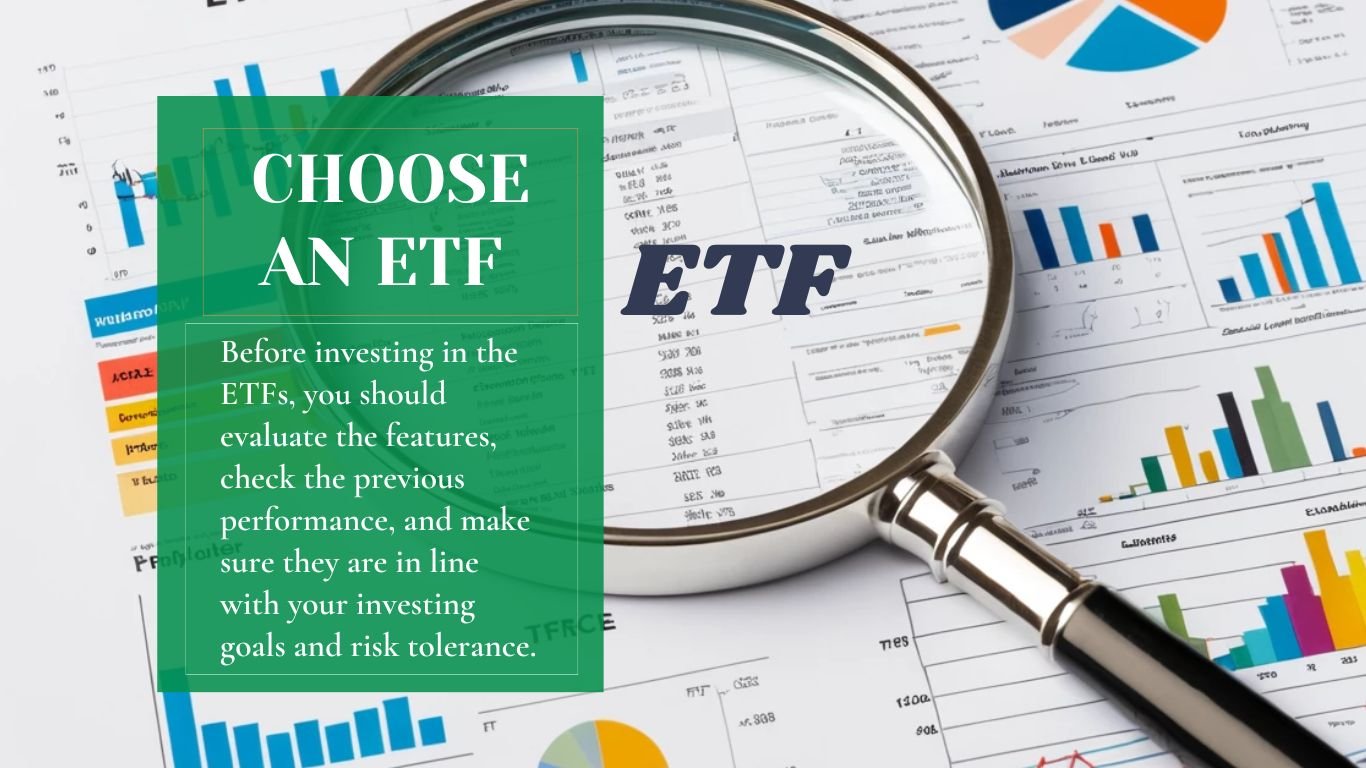To pick a suitable exchange-traded fund (ETF), take into account your investment goals, risk tolerance, fee and expense ratios, diversification, and historical performance. Assess ETFs’ expenses, tracking discrepancy, tax efficiency, asset class, risks, and market conditions for informed decisions.
Even though it may appear easy, finding a solid exchange-traded fund (ETF) is more complicated than just picking one at random. To achieve consistent performance and higher earnings, use more than ETFs for diversity and rapid growth.
Think long and hard about the stocks, commodities, or other assets that the ETF is funding, and assess the sector’s potential for growth.
To further improve your price prediction abilities, you may analyze the price chart utilizing Elliott Wave theory, or EMA. By considering these things, you may choose an ETF with more knowledge and greater profit.
How Do I Find Good ETFs?
With so many alternatives, choosing the best exchange-traded fund (ETF) might feel like an insurmountable mountain to climb. But if you have a plan and know what the important things are, you can make smart choices that align with your financial plans. In order to assist you in navigating the procedure, we have included a detailed guide.
Determine Your Investing Objectives and Comfort Level with Risk
Get your goals straight before you go headfirst into the ETF market. Can you tell me if you’re going for growth or income? Also, you should know how much risk you can handle. Are you willing to ride out temporary ups and downs in order to reap bigger rewards in the long run, or would you rather remain on the safe side? You may use the answers to these questions to narrow down your options for ETFs.
Learn How to Invest in ETFs
You must know your goals before investing.
Mutual funds provide a wide range of investment options, including actively managed funds and those that merely follow an index, such as the S&P 500. For those seeking consistent gain over the long term at a lower cost, passive ETFs are a beneficial choice. Actively managed exchange-traded funds, on the other hand, might be a suitable fit for those who are willing to take on greater risk in pursuit of possibly larger returns.
Assess the Essential Features of ETFs
When comparing ETFs, consider a number of important factors:
Fee and expense ratios: This metric will significantly influence your decision-making process because lower expense ratios typically result in higher net profits over time.
Diversification: Spreading money around across different assets, industries, or even countries is one way a diversified ETF lowers overall risk.
Tracking problem: This is a way to see how closely an exchange-traded fund (ETF) tracks its underlying index. Reducing tracking errors demonstrates that the ETF is performing as expected.
Think About the Market Position and Trading Volume
To determine its level of establishment, consider the ETF’s trading volume and market position. A larger trading volume is an indicator of liquidity for an exchange-traded fund (ETF), making it easier to purchase and sell shares. This becomes even more critical when the market is unpredictable.
Know the Structure of ETFs
ETFs can have physical backing from the assets they monitor or synthetic backing from derivatives. When you know the benefits and drawbacks of each structure, you may pick an ETF that fits your investing style.
Verify Both the Base Index and Past Results
If an ETF does well relative to its underlying index, then it will do well overall. You should check the index’s rebalancing frequency and technique to make sure they fit your approach.
Although it’s important to diversify your investments, trusting an ETF’s management and strategy becomes simpler when you consider its past performance.
If you follow these steps, you should be able to choose an ETF that fits your needs as an investor and puts you in a favorable position for financial success down the road. Although exchange-traded funds (ETFs) provide a lot of variety and flexibility, the key to getting the most out of your investment is doing your homework and picking the correct one.
How Do You Assess a Good ETF?
When evaluating exchange-traded funds (ETFs), it’s important to look at more than simply costs and returns. A thorough analysis necessitates delving further into the numerous aspects that influence its performance and portfolio compatibility. You can evaluate an excellent ETF in the following way:
How to Judge an ETF?
1. Evaluate the Expense Ratio
An ETF charges you an annual fee, known as an expense ratio, to manage your assets. In most cases, a lower expense ratio is preferable, as it enables a larger portion of your investment capital to remain invested.
A favorable exchange-traded fund does not always have a low cost ratio. Consider the extent to which the ETF aligns with its index. Even at a low cost, an ETF might underperform if it can’t match its benchmark.
2. Examine the Tracking Discrepancy
The tracking difference tells us how well an exchange-traded fund does in relation to its underlying index. A lower tracking difference is a positive sign for investors who are counting on the ETF to provide similar returns—it means the ETF is correctly mirroring the index’s moves.
Evaluate an ETF by looking at its one-year tracking difference in comparison to similar funds. An efficient and well-managed ETF will have a tracking difference that is stable and low.
3. Think About Tax Efficiency
While tax efficiency is a primary goal of most exchange-traded funds (ETFs), there are those that fall short. The capital gains distributions are a useful indicator of the profits distributed to shareholders. To reduce your tax burden, smaller payouts are preferable.
Think about the kind of exchange-traded fund (ETF) you’re putting your money into; long-term investors, in particular, should look into equities ETFs because they are often more tax-efficient than other types, such as currency or bond ETFs.
4. Asset Class and Strategy
Learn the ETF’s asset class or investment strategy before investing. You might expect varying levels of risk and profit from various asset types, such as stocks, bonds, and commodities. Evaluate the asset class in light of your investing objectives and how it complements your current holdings.
Also, check if the ETF’s strategy, if any, is well-grounded in theory and has a track record of success in different market environments, especially if it’s a momentum or value investing approach.
5. Analyze the Risks
Think about the ETF’s dangers in addition to its performance and tax effectivity. Exchange-Traded Notes (ETNs) are one type of ETF that carries the risk of exposure to a third party. Investigate the ETF’s closure carefully, as it could impact your investment strategies. Having a thorough grasp of these risks will enable you to make better judgments and steer clear of any problems.
6. Examine Base Assets and Current Market Conditions
The assets that an ETF owns have a direct correlation to how well the fund does. Look at the top holdings, as well as the areas or industries they represent.
Shifts in that specific market will more significantly affect the value of an ETF if it has a high concentration on one industry or area. Think about how the current economic cycle may affect ETF assets.
7. Compare to Industry Standards
You can tell if an exchange-traded fund is sector-specific by comparing its performance and price-to-earnings (P/E) ratio to the average for that industry. A lower P/E ratio might signal a buying opportunity, while a higher than-average P/E ratio could indicate that the ETF is overpriced.
8. Compare Trading Costs and Liquidity
Since ETFs trade similarly to stocks, their bid-ask spreads may impact your overall expenses. Narrower spreads, caused by more liquidity, lead to cheaper trading expenses.
If you want to open and exit positions effectively without spending too much money, you should check the typical trading volume and bid-ask spread of an ETF beforehand.
9. Think About the Intrinsic Value of the ETF
By estimating its intrinsic value, more experienced investors can determine whether an ETF is a smart investment at its current price. To do this, one must compare the present market price of the ETF’s holdings to their estimated future cash flows. An excellent chance to buy can arise if the ETF is selling for less than what it is actually worth.
How to Read an ETF Chart?
The ability to read an exchange-traded fund chart is crucial for predicting market movements, evaluating investment opportunities, and maximizing profits. An ETF’s price, like that of any other asset, can rise or fall depending on supply and demand, the value of the assets it tracks, and the mood of investors.
Price Action and Movement
Like any other asset, the price movement of an ETF primarily determines its value. Over time, the value of an exchange-traded fund (ETF) might rise or fall depending on how well the assets it owns are doing.
Following the ETF’s moving averages (MA) is a simple yet effective strategy for analyzing the chart. A moving average extracts the price information to determine the trend’s direction over a specific period of time.
As an example, you may make use of the Simple Moving Average (SMA) or the Exponential Moving Average (EMA), among others. In contrast to the SMA’s weighted average, the EMA prioritizes the most recent prices, making it more sensitive to fluctuations in the market.
For long-term investment analysis, use weekly or monthly candlestick charts, or any longer time frames. Taking a broad view enhances the ability to identify significant patterns and prevents loss due to transient market fluctuations.
Other Technical Indicators
There are a number of technical indicators you may use to better understand price movements:
Elliott wave theory, which identifies market wave patterns, makes predicting future price swings easier. For long-term corrections or rallies, it’s best to time your entry or exit points.
One such easy-to-understand yet powerful technique is the Darvas Box hypothesis. It entails drawing a box around price activity based on previous highs and lows. If the price moves outside the predetermined range, it might signal a new trend formation.
Selecting a Time Frame
They may look for intraday, daily, or even hourly charts to catch the ETF price’s rapid fluctuations. Monthly or weekly charts are more suited for investors who keep their investments for months or even years. You may use these charts to see long-term patterns and ignore the temporary fluctuations in the market.
Volume and Momentum Interpretation
The amount of the ETF that is being exchanged is shown. A rising price with increasing volume suggests a robust trend, but a dropping price with declining volume may indicate a deteriorating trend.
You may use the Relative Strength Index (RSI) to determine if the market is overbought or oversold by analyzing the rate and magnitude of price changes. An RSI below 30 indicates oversold conditions for the ETF, while an RSI above 70 typically indicates overbought conditions.
What Is the Best Tool to Analyze ETFs?
A powerful financial platform such as Bloomberg or Morningstar, along with an extensive charting tool like TradingView, is the ideal mix for analyzing ETFs. These sites provide detailed information on an ETF’s holdings, performance measures, cost ratios, and risk considerations.
With their sophisticated charting features, you can also apply technical indicators, compare ETFs to benchmarks, and evaluate their performance over time. These resources provide investors with a one-stop shop for fundamental and technical research, allowing them to make better judgments.
Final Thoughts
Expense ratios, tracking disparities, and underlying asset strategies are just a few of the many considerations that should be considered when picking a solid ETF. You can make decisions that align with your investing goals by thoroughly assessing how an ETF fits into your entire portfolio, accounting for both direct and indirect expenses, and having a basic understanding of the economic environment and the risks involved.
Keep in mind that the ideal ETF does more than just satisfy your short-term demands; it also helps ensure and enhance your financial security in the long run.













Leave a Reply